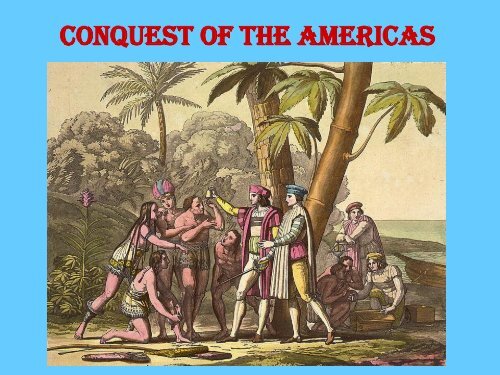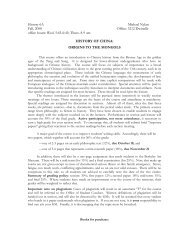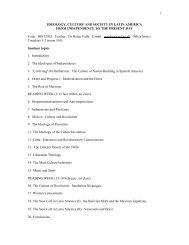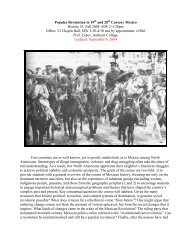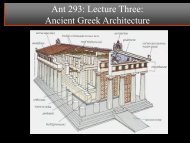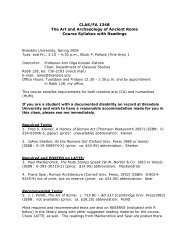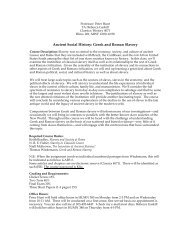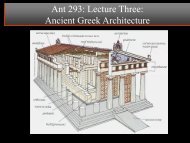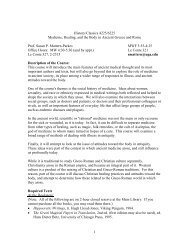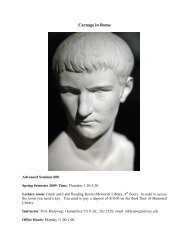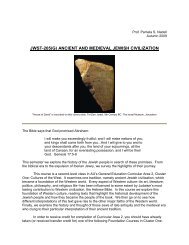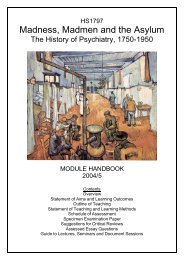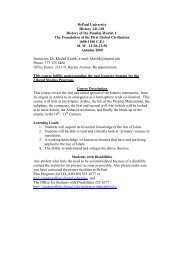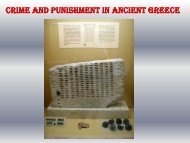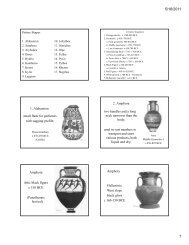Conquest Of The Americas - Mister Dans Home Page
Conquest Of The Americas - Mister Dans Home Page
Conquest Of The Americas - Mister Dans Home Page
You also want an ePaper? Increase the reach of your titles
YUMPU automatically turns print PDFs into web optimized ePapers that Google loves.
CONQUEST OF THE AMERICAS
<strong>The</strong><br />
Columbian<br />
Exchange
“<strong>The</strong> Arrival <strong>Of</strong> Cortez,” Diego Rivera
What words do we use to describe the past<br />
Discovery<br />
Invasion<br />
Encounter
THE CODEX BOTURINI: <strong>The</strong> departure of the Mexica Aztecs from Aztlan
Chicomoztoc:<br />
<strong>The</strong> Place of<br />
Seven<br />
Caves<br />
Compare this<br />
origin myth<br />
to<br />
the<br />
foundation<br />
legend<br />
of<br />
<strong>The</strong> Incas
THE LONG MIGRATION CONTINUES: <strong>The</strong> Aztecs pause from time to time to<br />
hunt and to sacrifice victims captured in skirmishes<br />
<strong>The</strong> men walking are god-bearers carrying symbols of the Aztec gods<br />
(<strong>The</strong> image of Huitzilopochtli as Reposing Shield brings up the rear)
HUITZILOPCHTLI (Patron God <strong>Of</strong> <strong>The</strong> Aztecs):<br />
“<strong>The</strong> Hummingbird <strong>Of</strong> <strong>The</strong> South”<br />
This scene represents his birth from Coatlicue (“Serpents Her Skirt”) on<br />
Coetepec (“Hill <strong>Of</strong> <strong>The</strong> Serpent”) -- Compare to the Birth of Athena
COYOLXAUHQUI DISMEMBERED<br />
This giant stone sculpture was placed at the base of the main temple at<br />
Tenochtitlan (an idol of Huitzilopochtli was at the top of the temple)<br />
•<strong>The</strong> bodies of sacrificial victims would come to a rest at this base when thrown down the temple stairs
<strong>The</strong> foundation of Tenochtitlan as depicted in the Codex Duran<br />
<strong>The</strong> eagle, serpent and cactus appear on today’s national flag of Mexico
Teotihuacan (“Place of the Gods”)<br />
Looking from the Pyramid of the Moon down the Avenue of the Dead towards the Pyramid of the Sun<br />
<strong>The</strong> Aztecs gave this place its present name and performed rituals here.<br />
It provided the model grid system for the layout of Tenochtitlan.
Tula (Centre of the Toltec Empire c. 900-1150 CE)<br />
As with Teotihuacan, the Aztecs folded the Toltecs into their myths.<br />
•Aztec rulers were said to be descended from the Toltecs.<br />
•<strong>The</strong> Aztecs told stories about Tula’s past downfall and how the<br />
ruler-god Quetzalcoatl had fled the city at its time of moral decline.
Royal<br />
Dynasty<br />
of<br />
Tenochtitlan
TRIPLE ALLIANCE (1428)<br />
Glyphs representing the coalition of Technochtitlan<br />
with Texcoco and Tlacopan
Tribute to Tenochtitlan from an imperial province<br />
Aztec Empire<br />
Inca Empire<br />
• Founded c.<br />
1428<br />
• Mesoamerica<br />
• Tribute as<br />
raison d’etre<br />
of empire<br />
• Loose<br />
imperial<br />
bureaucracy<br />
• Local leaders<br />
coopted<br />
• Nahuatl<br />
• Founded c.<br />
1438<br />
• South<br />
America<br />
• Land and<br />
Labour as<br />
raison d’etre<br />
of empire<br />
• Centralized<br />
imperial<br />
bureaucracy<br />
• Local leaders<br />
coopted<br />
• Quechua
An<br />
Aztec<br />
Eagle<br />
Warrior<br />
Aztec Warriors were also associated with<br />
• Jaguars<br />
• <strong>The</strong> Sun<br />
• Huitzilopochtli<br />
• Hummingbirds<br />
(Women in child-birth<br />
were also described as eagle warriors.<br />
On the birth of a baby, the mid-wife would<br />
shout a war-cry. Women who died in<br />
child-birth became goddesses who rose<br />
heaven-ward to accompany the sun from<br />
noon to sunset.)
Rewards for taking prisoners in battle ranged from a red feather<br />
costume (top left) for two prisoners to a jaguar costume (to right)<br />
for taking four, as explained in the Codex Mendoza
INTERPRETING THE PAST: <strong>The</strong> concept of “FLOWER WARS”<br />
What was the nature of Mesoamerican warfare<br />
To what extent was war about ritual than merely about power and conquest<br />
How should we compare Aztec conquest with Spanish conquest
A scene of human sacrifice from the Codex Duran
Mask of<br />
Quetzalcoatl<br />
Only one of<br />
several gods to<br />
have sacrificed<br />
his own blood<br />
on behalf of the<br />
universe and<br />
humanity
<strong>The</strong> Tudela Codex depicts various forms of blood-letting,<br />
including sacred self-mutilation.
An Aztec sacrificial knife fitted with chalcedony.
AZTEC CALENDAR STONE<br />
<strong>The</strong> Sun god Tonatiuh is in the centre. He is surrounded by symbols of the 4 previous suns or ages.<br />
<strong>The</strong> 20 days of the month surround this in a circle, while the two external circles of fire serpents symbolize time.
An Aztec Stone Bundle<br />
Carved to commemorate the end of a 52-year cycle and the last<br />
New Fire Cermony (1507 CE) before the Spanish <strong>Conquest</strong>.
<strong>The</strong> Aztec New Fire Ceremony
A day-keeper reads the destiny for an infant born on 10 Rabbit
THE CODEX BORGIA<br />
A screen-fold of deer hide, the Codex Borgia contains 28<br />
almanacs used in divination, as well as a creation myth.
Lienzo<br />
of<br />
Tequixtepec<br />
(A map of the<br />
community kingdom<br />
of that name, located<br />
in northern Oaxaca)
Eight high lords of Tenochtitlan<br />
Social Structure:<br />
Nobles: High lords (tetechuhtin); regular nobles (pipiltin)<br />
Commoners (machehualli): All others, including merchants (pochteca) and slaves (tlacotin)
An Aztec feather shield sent by Cortez to King Charles V
A late-15 th C.<br />
Aztec<br />
Lord
Tasks<br />
associated<br />
with the<br />
macehualli<br />
class
Aztec wooden-collar slaves
Aztec<br />
commoners<br />
attend a<br />
telpochcalli<br />
(“youth’s<br />
house”)
Tenochtitlan (Mexico City): <strong>The</strong> heart of the Aztec Empire
<strong>The</strong> Templo Mayor (back centre) towers above the sacred precinct
A sculpture from the Templo Mayor archaeological zone
A page from the Codex Mendoza shows Montezuma II inside his palace
A map of the<br />
Metropolitan<br />
Region of<br />
Tenochtitlan<br />
Includes<br />
Tlateloco<br />
(Site of the largest<br />
market in the <strong>Americas</strong>)
Hiram<br />
Bingham at<br />
Machu<br />
Picchu<br />
(1911)
Hiram Bingham Crossing <strong>The</strong> Urubama River Below Machu Picchu
A 1911 photo of Machu Picchu by Hiram Bingham
Part of the so-called<br />
House of the Princess,<br />
the wall joins with El<br />
Torreon, the semicircular<br />
structure that<br />
Bingham named the<br />
Temple of the Sun
Machu Picchu: Hitching Post <strong>Of</strong> <strong>The</strong> Sun
<strong>The</strong> Temple <strong>Of</strong> <strong>The</strong> Three Windows has been partly restored
Peruvian Potatoes
Felipe Huaman Poma<br />
de Ayala –<br />
<strong>The</strong> mestizo son of a Spaniard<br />
and an Inca wrote a massive<br />
1400-page letter to King Phillip<br />
III of Spain giving a history of<br />
the Incas before and during<br />
Spanish rule and complaining<br />
of colonial abuses of natives<br />
by the Spaniards.
Only a dry bed<br />
remains of a great<br />
canal that once<br />
linked the Moche<br />
and Chicamaca<br />
river valleys
A statue of<br />
Manco Capac<br />
in Lima
Manco Capac<br />
and his seven<br />
siblings emerge<br />
from one of the<br />
three caves at<br />
Pacariqtambo
Chavin de Huantar: <strong>The</strong> centre for Chavin culture (c. 1400 BCE-400 BCE)
Nazca and Moche Cultures: c. 370 BCE-540 CE close to coast
Tiwanaku’s massive Gate <strong>Of</strong> <strong>The</strong> Sun in today’s Bolivia
Map showing<br />
Inca<br />
archaeological<br />
sites
<strong>The</strong> ruins of Pikillacta, an old provincial capital of the Wari Empire close to Cuzco
Map showing<br />
the extent of the<br />
Wari and<br />
Tiwanaku<br />
empires
A statue of Prince Yupanqui or Pachacuti
Map of the<br />
Andean region<br />
in 1438 CE
Pachacuti as represented on a Cuzco Mural
Topa Inca,<br />
<strong>The</strong> 10 th ruler of<br />
the Incas<br />
(1471-1493 CE)
Huayna Capac,<br />
<strong>The</strong> 11 th ruler of<br />
the Incas<br />
(1493-1527 CE)
Map of the<br />
conquests of<br />
Pachacuti,<br />
Topa Inca and<br />
Huayna Capac
<strong>The</strong> four<br />
suyus of<br />
Tawantinsuyu
Records in the Inca Empire were kept on a device called the quipu
An Inca<br />
quipocamayoc
<strong>The</strong> governor of royal roads,<br />
his high rank apparent in the<br />
metal trapezoid on his<br />
headband, appears to be<br />
accepting the tribute that<br />
financed his upkeep. Behind<br />
him are three tambos, or<br />
roadside shelters.
Because their were no wheeled vehicles, Inca roads often climbed steep slopes
An Inca Road hugs a cliff<br />
on the way to Machu<br />
Picchu. Where logs now<br />
bridge a gap, a<br />
drawbridge once served<br />
as a check-point.
A modern reconstruction of an Inca suspension bridge made from hand-braided ichu grass
<strong>The</strong> Inca in charge<br />
of the Guambo<br />
rope bridge allows<br />
a traveler to cross
<strong>The</strong> son of a local<br />
leader, this messenger<br />
blows a conch-shell<br />
trumpet and wears a<br />
conspicuous feathered<br />
headdress. Both signal<br />
his approach. He is<br />
holding his weapons – a<br />
mace and a sling.
An Inca ushnu, the platforms that served as the centre for each provincial capital
A qollqa<br />
storage<br />
structure<br />
perched on a<br />
hillside at<br />
Ollantaytambo
Inspecting a group of<br />
eight storehouses, or<br />
qollqas – holding<br />
cotton, coca, sweet<br />
potatoes and corn – the<br />
emperor Topa Inca<br />
Yupanqui confers with<br />
an official who<br />
maintains a storage<br />
record on his quipu
Inca<br />
terraces
An Inca<br />
Fountain
Inca engineers straightened the meandering path of the Urubamba River.<br />
<strong>The</strong>y also graded the valley floor to produce acres of flat and cultivable land.
<strong>The</strong> central figure in the<br />
checkerboard tunic of a<br />
warrior displays a large<br />
disc on his chest to<br />
show that he is a<br />
general. He leads men<br />
wearing Inca ear spools<br />
against enemy soldiers<br />
of Charcas.
A statue of<br />
Pachucuti
This skull – probably the<br />
remains of a defeated opponent<br />
– may once have been lined with<br />
gold and used for chicha, a beer<br />
most often brewed from corn.<br />
Such skull cups served as<br />
symbols of victory for Inca<br />
leaders who triumphed in battle.
SOCIAL AND ECONOMIC STRUCTURES:<br />
THE BASIC DIVISIONS<br />
1) COMMONERS<br />
2) CURACAS<br />
• Local leaders who ruled directly over the commoners<br />
3) INCAS<br />
• Responsible for ruling the empire
Inca men and women<br />
harvesting potatoes:<br />
<strong>The</strong> great masses of people<br />
in the Inca Empire were<br />
commoners with little<br />
wealth and almost no<br />
political power. Commoners<br />
were forbidden to look at<br />
the highest-ranking Incas<br />
and were not allowed to<br />
leave their home<br />
communities without<br />
special permission.
CURACAS<br />
At the local level Andean society was fundamentally kin-based<br />
and typically organized under a hereditary ruler called a<br />
curaca.<br />
<strong>The</strong> Incas folded this pre-existing system into their imperial<br />
control.<br />
<strong>The</strong> hereditary curaca class became a provincial nobility<br />
responsible for administering the empire at the local level.<br />
<strong>The</strong> privileges enjoyed by the curacas included exemption from<br />
taxation, a paid salary, assigned servants based on the<br />
number of subjects ruled, and the right to be carried in a<br />
hammock or litter.<br />
<strong>The</strong>y could also be rewarded for outstanding service with<br />
secondary wives, lands, animals, fine cloth, and gold or<br />
silver objects.
CAPAC INCAS AND HAHUA INCAS<br />
<strong>The</strong> Incas themselves were divided into two classes based on<br />
blood and privilege.<br />
<strong>The</strong> Capac Incas were a class of people related by blood who<br />
were believed to have descended from the Inca founder<br />
Manco Capac. <strong>The</strong>y held all of the highest posts in the<br />
empire.<br />
To address the shortage of individuals available to fill all of the<br />
critical posts in an expanding empire, Pachacuti decided to<br />
make Incas out of all of the nearest neighbouring nobles to<br />
Cuzco who spoke Quechua. <strong>The</strong>se were known as the<br />
Hahua (“Outer”) Incas.<br />
Only Capac Incas could become emperor and rule the land.
An Inca Gold<br />
Figurine
THE SAPA INCA<br />
<strong>The</strong> “sole Inca” or the “unique one.”<br />
As a direct descendant of Manco Capac, he was seen as a son<br />
of the sun god Inti and therefore as semi-divine.<br />
He was carried in an elaborate litter, and held court from behind<br />
a screen of cloth.<br />
No one was allowed to look him in the face, and all those who<br />
approached him, even nobles, had to removes their shoes<br />
and carry a token burden on their backs.<br />
Like the nobles, he had one principal wife and numerous<br />
secondary wives and concubines.<br />
In the later reigns, it was the custom to have the emperor marry<br />
a full sister in order to keep the Capac Inca bloodline intact.
PANACAS<br />
<strong>The</strong> panaca was an institution peculiar to the royal Incas. It was<br />
composed of the descendants of a reigning emperor but<br />
excluded the ruler himself.<br />
<strong>The</strong> purpose and function of this organization was to preserve<br />
and protect after his death the emperor’s mummy, and his<br />
huaoque image, which was a statue that could stand in for<br />
the Sapa Inca at ceremonies when the ruler needed to be<br />
elsewhere.<br />
<strong>The</strong> members of a panaca acted as stewards of the palaces and<br />
royal estates. None of this wealth was passed on to the next<br />
ruler but was kept perpetually in the care of the panaca.<br />
Panacas were extremely powerful politically and no emperor<br />
could effectively rule without their consent.<br />
By the time of the Spanish <strong>Conquest</strong>, there were 11 panacas.
YANACONA<br />
A special class of people outside of the normal hierarchy but<br />
still subject to the nobility was the yanacona.<br />
It is not inappropriate to describe them as servants, but they<br />
were not ordinary servants. In fact, becoming a yanacona<br />
was one of the very few paths to upward mobility in the Incas<br />
Empire.<br />
As a class, they owed their loyalty to and received their support<br />
from individual nobles or emperors and sometimes were<br />
attached to institutions such as temples or royal estates.<br />
Yanacona severed all ties to their home communities.<br />
<strong>The</strong>y also received the privileges of exemption from taxes and<br />
the authority of their native curaca, and their children could<br />
inherit yanacona status.
ACLLAS<br />
Another class operating outside of the regular social hierarchy<br />
were the so-called “chosen women,” or acllas.<br />
Each year the emperor sent out to the provinces royal<br />
inspectors to collect tribute to be paid to the state in the form<br />
of girls.<br />
From each village, the most beautiful between the ages of 10<br />
and 12 were selected. Being chosen was considered a great<br />
honour and represented a path of upward mobility in Incas<br />
society.<br />
<strong>The</strong>se girls were taken to Cuzco and divided into several<br />
classes based on their social standing, skills and perceived<br />
beauty before being assigned to the aclla was (house of the<br />
chosen women) in Cuzco or the provinces.<br />
<strong>The</strong>y never married, and violation of their chastity would be<br />
punished by death. <strong>The</strong>y spent their days tending the<br />
temples.
<strong>The</strong> remains of the Cuzco Acclahuasi
A pair of nobles build walls<br />
symbolizing the division of land<br />
among the emperor, the<br />
religious establishment and the<br />
community. In reality, the elite<br />
set the boundaries and the<br />
commoners erected the walls.
An Inca Tunic
A re-creation of the Inti Raymi Festival
Viracocha –<br />
<strong>The</strong><br />
Inca<br />
Creator<br />
God
A representation<br />
of an Inti Raymi<br />
Festival
Found near the body of a<br />
boy who was probably<br />
sacrificed to the sun<br />
god, this silver figurine<br />
clad in parrot feathers<br />
and luxurious vicuna<br />
wool may represent a<br />
deity intend as the<br />
child’s escort into the<br />
next world.
Bent in a fetal position,<br />
the seven-year-old boy<br />
found in Aconcagua was<br />
wrapped in a cloak of<br />
yellow macaw feathers<br />
and several embroidered<br />
blankets. This body was<br />
painted red, a symbol of<br />
life.
A scientist<br />
removes hair<br />
from a sacrificial<br />
victim
<strong>The</strong> ruins of the ancient temple of Pachacamac
Considered a huaca, or<br />
mystical place, by the Incas,<br />
this natural fissure sits<br />
beneath the so-called<br />
Temple of the Sun at Machu<br />
Picchu. Stonemasons<br />
carved steps, altars and<br />
niches into its granite<br />
interior and constructed a<br />
wall, at right, to link it to the<br />
temple above.
To demonstrate the sizes of his mummy bundles relative to that of a<br />
living person, archaeologist Max Uhle posed a workman with two of his<br />
finds during his 1896 dig at Pachacama, on the southern coast of Peru.
Draped in a cloak of<br />
plumes and shed in<br />
sandals of wool and<br />
leather, this mummified<br />
man was 35 years old<br />
when he died. He lived<br />
sometime between the<br />
third and seventh<br />
centuries CE.
At Diablo Huasi, just south of Pueblo de los Muertos, dozens of<br />
tombs mark the cliff face. One cave contained numerous<br />
mummies with their knees drawn up to their chests, wrapped in a<br />
net-like material, and surrounded by grave goods.
Poma de Ayala<br />
illustration of an<br />
Inca mummy<br />
being<br />
transported.
CONQUEST OF THE AMERICAS<br />
• 1492: First voyage of Columbus<br />
• 1493: Founding of Santo Domingo<br />
• 1500: Portuguese expedition of Cabral stumbles on Brazil<br />
• 1506: <strong>Conquest</strong> of Puerto Rico<br />
• 1511: <strong>Conquest</strong> of Cuba<br />
• 1513: Balbo reaches Pacific<br />
• 1518: Founding of Panama<br />
• 1519: Spaniards make first contact with Aztecs<br />
• 1521: Death of Ponce de Leon in Florida<br />
• 1521: Fall of Aztecs<br />
• 1520s: 8-year odyssey of Cabeza de Vaca in North America<br />
• 1532: Pizarro meets Atahullpa<br />
• 1544: Assassination of Manco Inca<br />
• 1540s: Pedro Alvarado’s conquest of the Maya<br />
• 1549: Portuguese establish colonial presence in Brazil with<br />
founding of Bahia<br />
• 1572: Execution of Tupac Amaru
Hernan Cortes as a latter-day St. James, freeing the Aztecs from human sacrifice
<strong>The</strong> meeting between Cortes and La<br />
Malinche as portrayed in the Codex Duran
Cortes meets the ambassadors set by Moctezuma
<strong>The</strong> coronation<br />
<strong>Of</strong><br />
Moctezuma II<br />
(1503)
<strong>The</strong> legend of Quetzalcoatl as represented by Diego Rivera
Cortes sinks his fleet as represented in a 16 th -century Spanish painting
<strong>The</strong> Church of the Virgin of Remedies – reputedly founded by Cortes –<br />
stands on the site of the ruined temple at Cholula.
<strong>The</strong> sacred volcano of Popocatepetl
Narrative scenes<br />
from the<br />
Florentine Codex<br />
Emissaries of Montezuma<br />
meet with Cortes on the<br />
road and then report back<br />
to a distraught emperor.
Cortes welcomed<br />
at the<br />
court of<br />
Montezuma
Montezuma shows Cortes the shrine of Huitzilopochtli
Skull-mask representing God of Death found at Templo Mayor site
Alvarado and his fellow conquistadors kill several Aztecs in<br />
the temple precinct (from the 16 th c. Duran Codex)
Montezuma is forced by the Spanish to appeal to his people
“<strong>The</strong> Night <strong>Of</strong> Tears”: <strong>The</strong> conquistadors<br />
fight their way out of Tenochtitlan
A smallpox pandemic devastates the Aztec capital
<strong>The</strong> return of Cortes depicted in a heroic 16 th c. painting
According to Aztec sources, there were several celestial premonitions associated<br />
with the Spanish <strong>Conquest</strong>. This 1519 comet preceded the arrival of Cortes.
Cuahtemoc surrenders to Cortes<br />
August 13, 1521 or Day 1-Serpent in the Year 3-House . . .<br />
Depending on the calendar used
Portrait of Cortes as a Spanish gentleman from a<br />
painting in the Hospital of Jesus, Mexico City
Francisco<br />
Pizarro
Pizarro and Diego<br />
de Almagro sailing<br />
to Peru as<br />
represented in<br />
Poma de Ayala’s<br />
account
<strong>The</strong> meeting of Pizarro and Atahuallpa at Cajarmarca, 1532
Francisco<br />
Pizarro demands<br />
a roomful of gold<br />
in a somewhat<br />
fanciful depiction
Atahuallpa’s prison room and ransom room in Cajamarca
<strong>The</strong> execution of Atahuallpa (1533)
Cuzco, the capital of the kingdom of the Incas
Remains of the palace of the Inca at Cuzco
An idealized portrait of Manco Inca drawn by Waman Poma (1612)
Manco Inca leads the siege of Cuzco
Manco Inca retreats over the mountains and founds<br />
Vilcabamba in the rain forest bordering Amazonia.
Tupac Amaru (executed by the Spanish in 1572)
Gold from<br />
the <strong>Americas</strong><br />
in the statuary<br />
behind the altar<br />
of the cathedral<br />
in Seville, Spain
<strong>The</strong> richest silver mines in the world opened at Potosi in 1545
<strong>The</strong> myth of El Dorado, the “golden man”
<strong>The</strong> Spanish in Florida in the 16 th century
Ponce de Leon Park, Venice Florida
Cabeza de Vaca<br />
depicted as a<br />
healer on a<br />
mural in the<br />
town hall<br />
at Ojinaga
A 1542 chart with the north-south axis reversed<br />
shows native labourers in Brazil building a stockade
Bartoleme de Las Casas, A Short Account of the Destruction of the Indies, 1542
Waman Poma, 1613
Mural in today’s Cuzco commemorating the insurrection of<br />
Tupac Amuru II (1780-1781)
A mural commemorating the life of American rapper Tupac Amaru Shakur
Virgin of Carmen Festival held east of Cuzco
Interior of church during festival of Qollor Ri’l
Virgin of Guadalupe<br />
of<br />
Tepeyac, Mexico
God painting the<br />
Virgin of Guadalupe<br />
that appeared on the<br />
cloth of Juan<br />
Diego’s apron
Basilica of Our Lady of Guadalupe on top of Tepeyac Hill
Mexican boy<br />
dressed as<br />
Juan Diego
Mexico City<br />
today.<br />
<strong>The</strong> Metropolitan<br />
Cathedral is in<br />
the centre with<br />
the Templo Mayor<br />
site in the<br />
foreground.
Aztec monument of Coatlicue (unburied in 1790)
<strong>The</strong> National Museum <strong>Of</strong> Anthropology, Mexico City
<strong>The</strong> discovery of the dismembered Coyolxauqui (1978)


